This is an account of the brutality that can occur when identity and hate are used as weapons in politics.
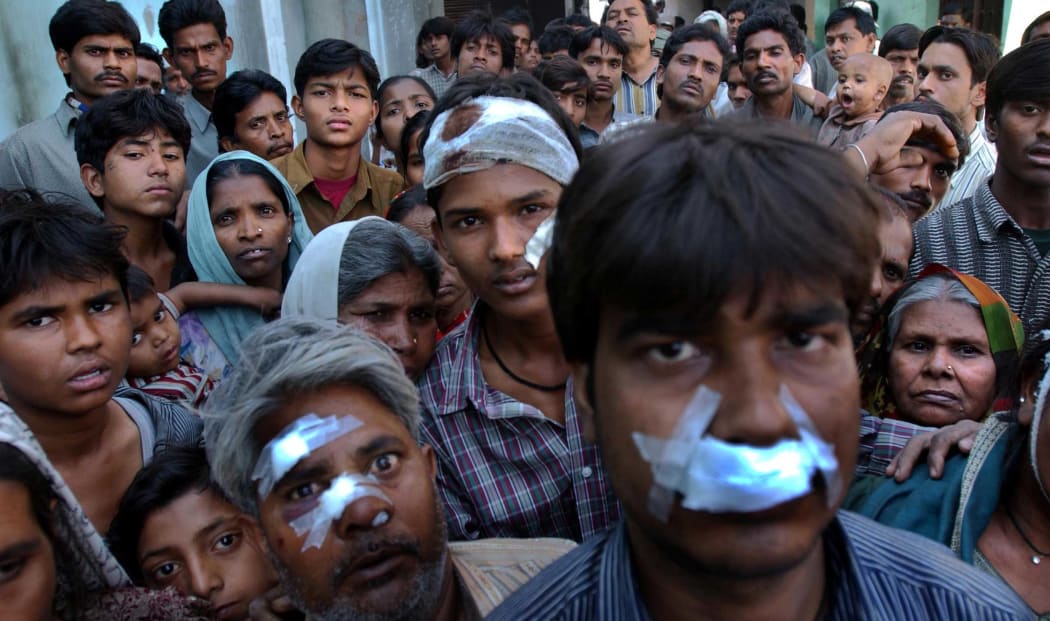
Muslims who had begged police to protect them the day before sit huddled in the wreckage of their burned out homes after a mob of Hindu neighbours attacked them from across a street. Photo: Getty
In early 2002, after a train fire killed 58 Hindus, a frenzy of violence against Muslims killed more than 2000 people. The Chief Minister of Gujarat, Narendra Modi, called the massacre "remarkable restraint under grave provocation", but the Indian National Human Rights Commission found his government complicit in the killing.
Did the Gujarat government plan the massacres to help win the state election?
_________________________________________________
"Where are you staying in Ahmedabad?"
The question was friendly but a cold stare accompanied the easy smile. The RSS man's professional smile had been quite unaffected by increasingly uncomfortable questions during our interview but the temperature of his eyes had steadily dropped.
His polite answers grew increasingly less so before he finally shut me down with a blunt ''I don't understand your English''. His eyes made me uneasy.
He was a local leader of the RSS (or National Volunteer Corps), one of the family of Hindu nationalist organisations (the Sangh Parivar) of which the BJP is the political arm.
I'd been asking him about the RSS and their role in the 2002 massacres of more than 2000 Gujaratis; an event the European diplomatic investigation described as "genocide" and most observers agree was an uncommonly brutal - and very successful - electoral tactic by the BJP party to turn communal tension into sectarian support in the run up to an election they were predicted to lose.
Their detractors sometimes describe the RSS as a fascist organisation and while they deny this charge, you can see how it arises. Its second leader M.S Golwalkar praised the anti-semitic policy of Nazi Germany as "race pride at its highest".
The RSS National spokesman enthused to me about the thousands of young members who attend indoctrination camps where they are taught the Hindutva version of Indian history and are drilled in Indian martial arts. Members parading in Khaki pants like an Indian version of Hitler's brown-shirts don't lessen the impression.
I didn't want to say where I was staying to a man so obviously upset at me and from a group accused of a calculated, efficient and brutal pogrom. A paranoid corner of my brain was considering the issue of personal safety and for good reasons.
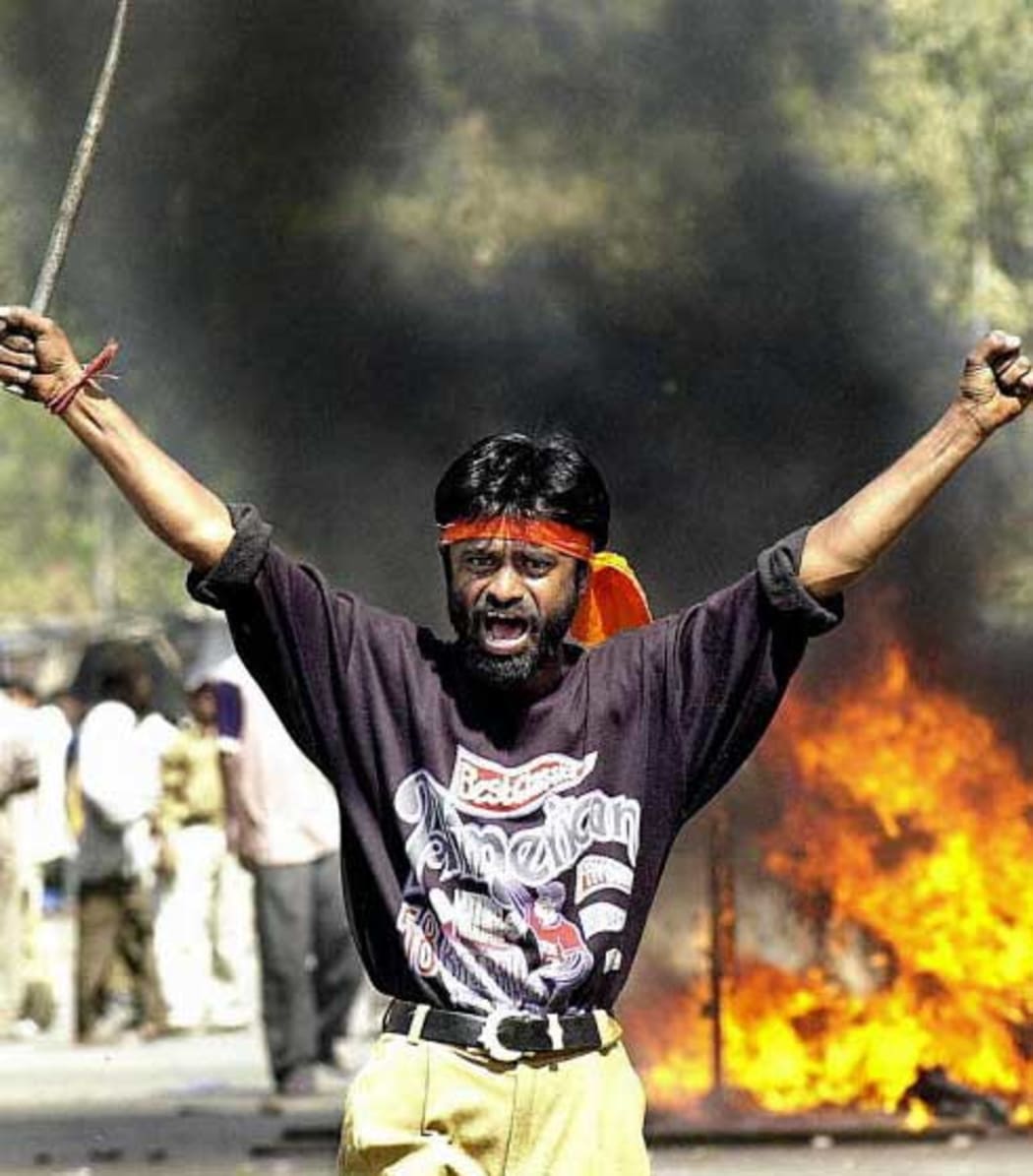
This picture taken 28 February 2002 shows an IndianBajranj Dal activist armed with a iron stick shouting slogans against muslims as they went burning muslim shops and attacked residences at Sahapur in Ahmedabad. Photo: Getty
The day before I'd visited the RSS's sister-organisation, the VHP (World Hindu Congress) where opinions were less guarded. The VHP is another member of the Sangh Parivar of Hindu nationalist organisations which include the RSS and the ruling party of the Gujarat State and Federal India, the BJP.
The VHP's website at that time encouraged all Hindus to follow a list of resolutions called the 10 commandments 'I will not buy from Muslims, I will not sell to Muslims, I will not work for Muslims, I will not hire Muslims. I will not…'. If the RSS can be characterised as the ideological head of the Hindutva movement, the VHP is its bully boy and fund-raiser.
Outside the local headquarters guards held shotguns and what looked like submachine guns. Inside, the dim wood-floored hall served as both a training hall and Hindu shrine. Its walls held memorials to the Sabarmati Express 'martyrs', and rows of guns racks which by my count nestled 60 rifles.
I'd met a local leader in his office there. He reminded me a bit of Captain Mannering from Dad's Army, but it had been more of a rant than an interview - I was told how Muslims were a dangerous and insidious foreign interpolation in India, that they constantly raped and abducted Hindu women, forcing them into Muslim marriages, and how India must one day take back Pakistan. By force if necessary. What were the guns for? "They are for training our young men and women…"
On the front page of that morning's paper the youth wing he described, the Bajrang Dal or the army of Hanuman (a Hindu God), were accused of trashing a nearby rural clinic the day before it opened. The justification was because it had been partly funded by a Christian aid organisation. This was excused as just lads being boisterous and an expression of legitimate anger at unwanted foreign involvement. Foreign meant non-hindu.
All things considered, the RSS men weren't making me enthusiastic about offering up personal details. I had already begged-off their request for a photo by claiming camera-shyness but really I was just nervous.
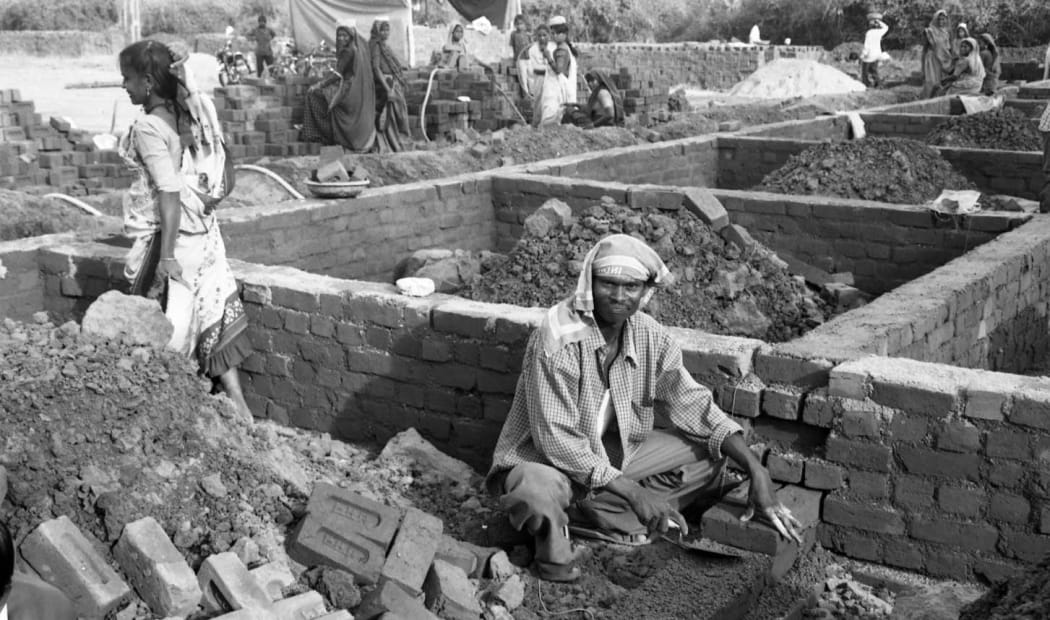
Building a new village for the dispossessed after the Gujarat Massacres. Photo: Phil Smith
A local Jesuit priest I'd met told me of being approached in the street by a group of young men who had stopped him, positively identified him with the help of a recent newspaper photo, and then badly beat him. He believed they were Bajrang Dal. I'd decided against photos.
Nervousness arises easily when you're alone in a foreign place. It might even be useful. It certainly leads to little monologues of doubt and risk-assessment which on this trip didn't stop me getting very politely mugged, or caught up in a brawl at a taxi stand, or being locked out of the external door of a moving train. So much for useful nervousness.
There are dozens of hotels in Ahmedabad and mine wasn't somewhere you'd expect to find a foreign journalist. It was a little place in the Muslim quarter and the only people who knew I was there (other than the Muslim staff) were the police to whom the hotel had to give my details. And so like a fearless journalist, I fudged it.
"Oh golly, I can't remember what's it's called, I've been in such a succession of hotels, they all just…"
"The Kamran."
It wasn't a question. It was a statement and it was correct. The little smile that played across his lips told me he'd' gotten the reaction he was looking for. The purpose of this exchange had nothing to do with where I was staying.
He had said few words but the message was clear, ''Don't piss us off, the police are in our pocket and we know where you live.'' He was right on all counts. The police were certainly on his side. And the state government as well.
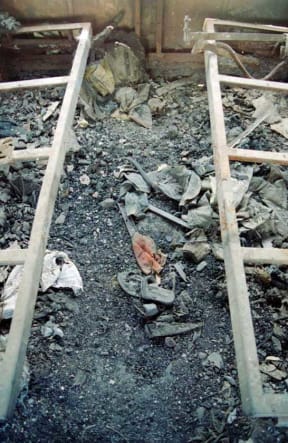
Burnt train carriage at Godhra, Gujarat 2003. Photo: Phil Smith
A member of then Chief Minister Modi's own inner circle blew the whistle, telling an investigating tribunal and Outlook magazine (3 June, 2002) that Modi called a secret meeting at his own bungalow on the evening of the Sabarmati Express tragedy at Godhra, including the Home Minister and the Commissioner of Police.
The Minister told the tribunal that at this meeting Modi "made it clear that there would be justice for Godhra the next day", and "ordered that the police should not come in the way of 'the Hindu Backlash'."
The 'backlash' was for the death of those 'martyrs' who had died on the Sabarmati Express, when a train carriage caught fire and all on it tragically perished.
They were reported to be Hindu pilgrims returning from a vist to Ayodhya, a small town with a disputed religious site. Ayodhya had been home to the Babri Masjid, an ancient mosque that dated back to the moghul era and stood on a site that Hindhu nationalists claimed was the birthplace of the god Ram.
This event had been marked by a Hindu temple until it was demolished by the Moghuls in the 16th century. The Indian Supreme court had ordered that the Babri Masjid be protected but in December 1992 L.K. Advani, a senior BJP politician had led a mob of thousands to the site where they demolished it by hand and by sledge hammer. The action sparked riots across India that killed more than 1000, mostly Muslims. It had been the most deadly rioting since partition - until Gujarat.
That train fire in Godhra (a quiet, largely Muslim town) was the spark for a conflagration that spread across the state. When I visited Godhra a year after the fire the carriage was still there, a rust-coloured, burnt out hulk sitting on a siding, the metal bars on its windows twisted with heat. Inside, the carriage was empty and echoing, with a thick layer of ash on the floor and a mangled assortment of mattressless fold-down beds.
I could understand the anger at the tragedy, but despite a response that smacked of 'Arrest the usual (Muslim) suspects' there was no plausible evidence that anyone had caused it. Train fires aren't unknown as passengers are wont to set-up camp stoves to heat meals. Whatever caused the fire, it was a perfect excuse for the massacre that very quickly swept across the state.
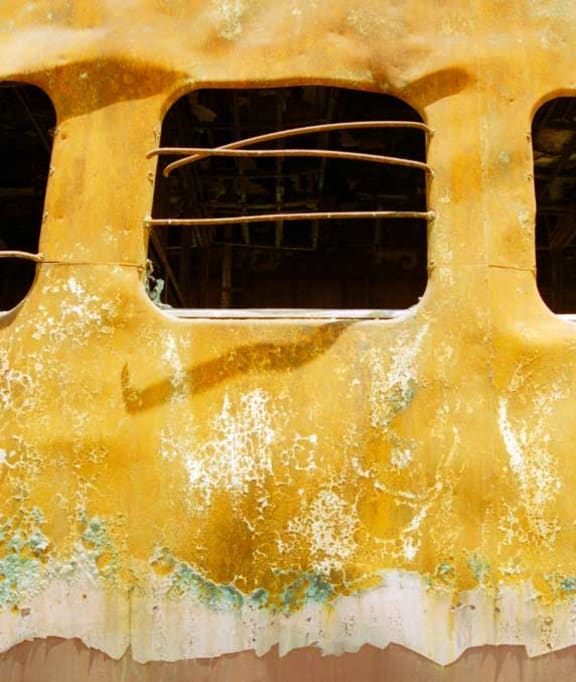
Burnt train carriage at Godhra, Gujarat 2003. Photo: Phil Smith
Whether the governing BJP or their fellow Sangh Parivar groups were involved in planning or leading the massacre is still unclear but they certainly did nothing to intervene. The Human Rights Watch investigation into the massacres was titled "We Have No Orders to Save You", a statement that is possibly best exemplified by just one small horror among many.
The Gulbarg Society was a walled area of expensive new houses in Ahmedabad, amongst them the large multi-story concrete dwelling of Ehsan Jafri, a retired Congress member of parliament. At about 10:30 a Hindu mob surrounded the compound, breaking through the high stone walls an hour or so later with the help of gas cylinders. Witnesses state that the rioters came armed with machetes, kerosene and printouts of names and addresses for Muslim owned properties, so as to more effectively purge neighbourhoods.
The Muslims in the Gulbarg Society all rushed for the safety of Ehsan Jafri's house. He was a prominent former Congress party MP and as such he had powerful friends, even if he was Muslim and the Hindutva opposition were now in power. And with a police station less than a kilometre away they believed they would be rescued soon. With the mob surrounding the house and chanting "Maro, kato. Mian ko mao" (kill them, cut them, kill the Muslims), Jafri telephoned everyone he could think of; the Chief of police, the governors office, politicians… support was promised but no support came.
Importantly, time was not a factor in a rescue. Having arrived in the morning, it was not until afternoon tea time that the mob started killing people and at 4:30pm Ehsan Jafri was cut down, covered with kerosene and burnt.
Sixty nine people died in that small compound and a further 85 were injured. The nearby police station apparently had 130 police on duty that day with supplies including tear gas.
And not one went to the compound to intervene.
As the HRW investigation said "we have no orders to save you".
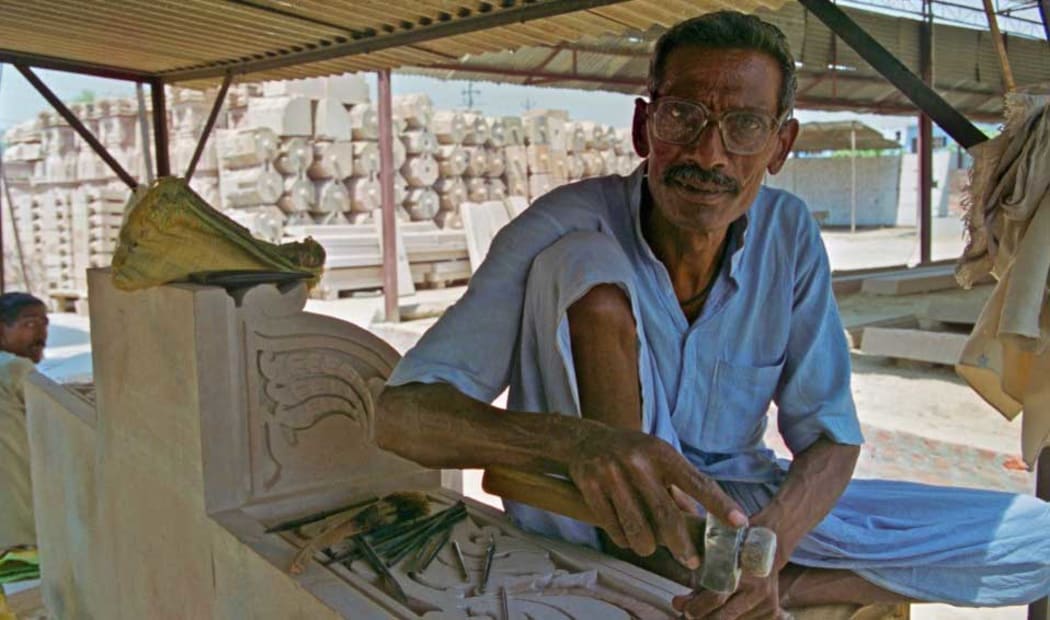
A craftsman carves pieces for a new quick-erect Hindu temple planned for the Ayodhya Babri Masjid site. Ayodhya, UP 2003. Photo: Phil Smith
And yet, an official investigation found no fault in the governor's office for that event, or any event, instead implying that Jafri had caused his own death by inciting legitimately angry rioters.
Not too far from Jafri's house in a poorer area that is a warren of small alleyways witnesses told me that police actively herded the victims towards the rioters. (The audio documentary on this webpage begins in these alleys with one woman's account of that day).
There have been many investigations since then, both official and private. Federal institutions have forced the Gujarat state to restart and reinvestigate, but even with thousands dead almost no-one has been charged, or punished and no-one has ultimately been held accountable.
More than a decade after the events the BJP has become the ruling party and the then Chief Minister of Gujarat, Narendra Modi, is now the Indian Prime Minister. And now the instruments of state that should be seeking justice for the victims are instead investigating, harassing and charging the Human Rights activists who have spent the last decade arguing for accountability. Activists like Teesta Setelvad.
I never managed to interview anyone from the Gujarat BJP government back in 2003. The office of the Chief Minister Narendra Modi slammed the phone down. And just to make their message clear, they did it again when I rang back.
But not everyone in the Hindu Nationalist movement was so shy. A few days later in the bristling heat of Ajmer, Rajasthan, I found the then World Secretary General of the World Hindu Congress - the other arm of the Sangh Parivar. Gujarat surgeon Praveen Togadia had just been released on bail after 10 days in jail on a charge of sedition.
Rajasthan had a Congress party government and Togadia had come on a trishul diksha to foment hindutva in the run up to the Rajasthan state election. I talked to him over lunch, while behind him two large minders (Gujarat Policemen I was told) stood with sub-machine guns. He had no need of their added menace. While he stuffed his first meal as a free man into his mouth he spat and ranted about Muslims and his hatred was raw.
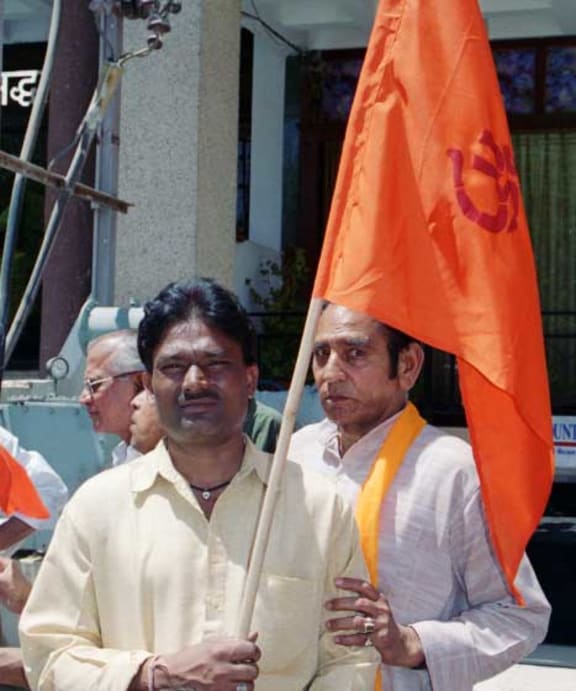
Hindutva supporters outside Praveen Toagia's Jail-release Press Conference, Ajmer Rajasthan. Photo: Phil Smith
It wasn't the polite menace of the RSS man who asked me where I was staying, or even the fervent anger of the VHP man who seemed to genuinely believe that all Muslim boys were looking for good Hindu girls to rape, but that no Hindu girl would ever look at a dirty Muslim boy. It was rage, mouth specking, wild eyed fury.
I'd been shown stomach churning photos of victims a week or so earlier and had struggled to quite comprehend them. People with their stomachs spilling out, children cut and burnt, charred men with arms hanging lose where they tried to fend off attacks.
The brutality of it was just too hard to take in. And the effects of the mob were at odds with the surprisingly calm demeanour of the men I'd met who praised their actions as an understandable, even legitimate and proportionate response to the train tragedy.
But talking with Praveen Togadia, the inhuman photos I'd seen of victims finally made sense.
They were made possible by Hindutva building a cultural identity as an exclusive, oppositional thing. 'I am not them, I am special, they are the opposite of me.' And it was the inevitable physical manifestation of using hatred as a tool in politics.
Gujarat was an experiment in the political usefulness of cultural identity and religious fear. Sadly, it was all too successful.

